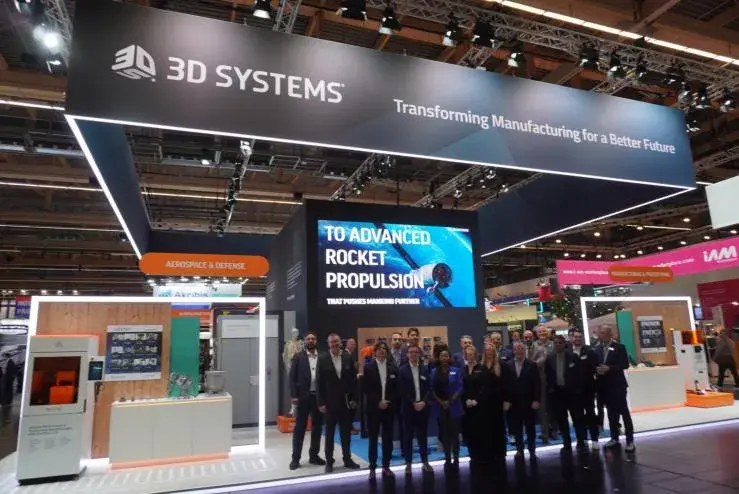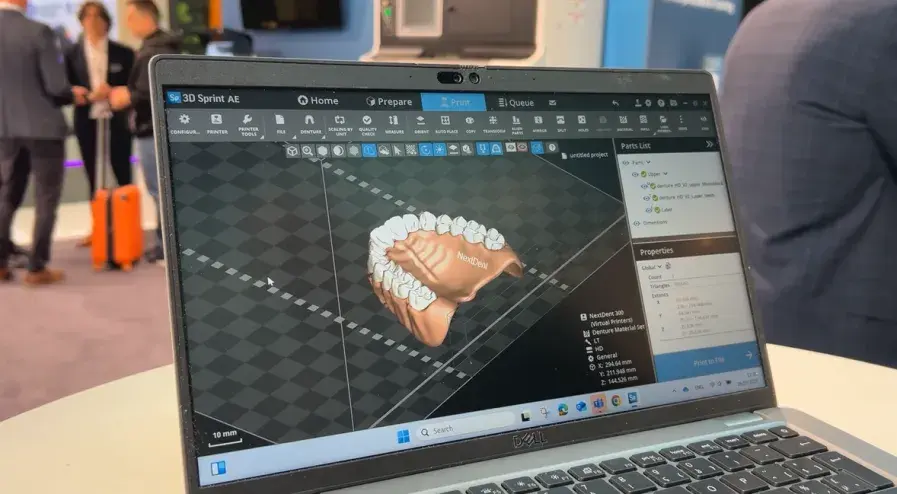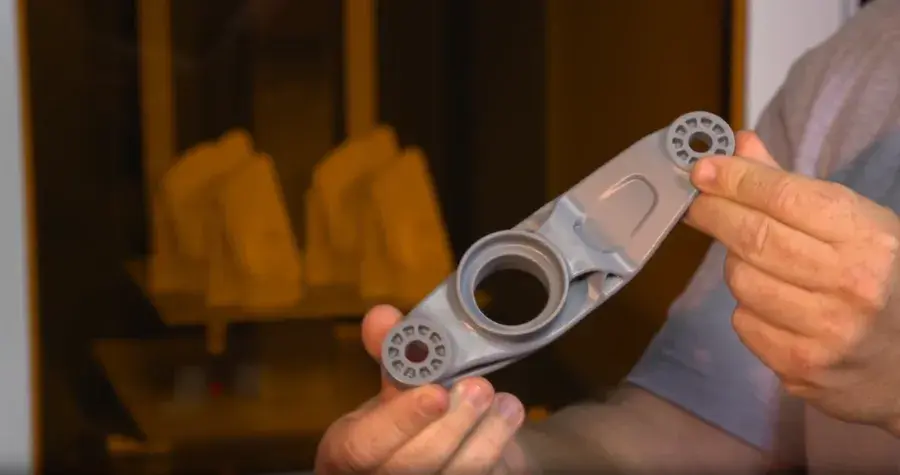2024 Additive Manufacturing Trends and Predictions
What is the outlook for additive manufacturing (AM) according to our leaders? AM is a clear gamechanger across a variety of industrial and healthcare markets, and our leadership team foresees several key additive manufacturing trends they believe will have a positive impact on the AM industry.

Throughout 2023, we’ve continued to see significant advancements in the use of additive manufacturing (AM) to fuel innovation across both industrial and healthcare markets. The technology has been transformative in a variety of industries, but I anticipate in 2024 we’ll see AM generating greater momentum in semiconductors, durable consumer goods, aerospace and defense, medical devices, and dental.
Across industries, I anticipate the integration of AM for production applications will continue to make important strides in helping to mitigate supply chain disruption. Industry-leading manufacturers continue to realize that AM enables them to take control of their supply chains by manufacturing locally. This in turn helps reduce costs by reducing the number of suppliers and removing the need for costly logistics providers to move components across geographies. This also has the potential to positively impact the environment by minimizing manufacturers’ carbon footprints.
The trend toward controlling the supply chain is demonstrating very strong traction in healthcare, especially in the production of medical devices at the point-of-care. Leading providers are investing in additive manufacturing solutions that are housed within hospitals and surgical centers to produce personalized devices such as implants and surgical tools. As we move through the coming year, I believe we’ll see the adoption of AM by healthcare institutions accelerate as surgeons and providers strive to produce devices that can positively impact patient care and the patient experience.
I also expect AM’s ability to enable the personalization of devices will play an important role in the dental industry. Digital dental solutions are already widely used to produce prosthodontics, orthodontics, and implants. In 2024, I anticipate a shift from AM playing an integral role through indirect production for the creation of molds to the direct production of devices. Additive manufacturing’s ability to enable not only the production of patient-specific devices but also mass customization can yield an unmatched method for everything from custom surgical guides and implants to dentures and orthodontic appliances.
Moving from healthcare to industrial applications, the semiconductor industry continues to face significant challenges in its ability to address the ongoing chip shortage brought on by the pandemic. While AM has demonstrated advantages in semiconductor capital (semicap) equipment for more than ten years, I anticipate it will play a growing role in the coming year for its ability to accelerate time-to-market and enable the production of parts with improved performance. This will be possible due to additive’s ability to deliver incredibly complex parts with exacting accuracy that would not be possible to achieve using traditional methods. Additionally, these unique parts can improve how semicap equipment operates, thus enabling faster production and reducing the time to market for the much-needed chips.
I believe AM’s ability to accelerate innovation will also play a key role in consumer goods. As the barriers to entry have become lower, the adoption of AM as a production technology continues to accelerate. This is becoming abundantly apparent in the durable consumer goods industry where AM was once viewed only as an enabler for prototyping which could shorten product development. As we move into 2024, I anticipate many consumer goods manufacturers will continue integrating AM into production workflows for many applications, especially in the electronics industry. Consumers continue to seek out the latest technologies that help facilitate how they both communicate and manage their personal lives. AM’s ability to catalyze the pace at which companies innovate will not only enable faster product development times but also enable the development of products that push the possibility of what can be delivered to give consumers never-before-imagined capabilities.

Additive manufacturing (AM) is already demonstrating its ability to transform manufacturing workflows for a variety of industrial applications. We continue to see advancements in casting and aerospace, as well as oil and gas. However, as we enter 2024, I believe we’re going to see AM play an increasingly important role in two industries – semiconductors and durable consumer goods.
Semiconductor lithography and wafer processing equipment require constant innovation to meet the accuracy, speed, reliability, and productivity demands of increasingly complex microchip production. Additionally, the continual need for increased quality, improved total cost of ownership, reduced time to market, and minimized supply chain disruption persists.
AM has demonstrated benefits in the semiconductor capital equipment industry for more than a decade and has grown quickly in the last few years. So, while additive is not new in this industry, we are seeing the technology gain momentum and I anticipate it will make an impact in two key areas:
- Accelerating Development Time: Reduced manufacturing complexity and planning cycles will translate to a shorter time to market for innovation. I believe this will be especially apparent for those manufacturers that produce super high-density features such as high-end solid-state memory, and high-performance processors. I also believe this will positively impact foundry yields which will in turn help to bring an end to shortages.
- Improving Performance: With AM enabling a new generation of semiconductor capital equipment that is more capable and precise, I anticipate this will in turn enable new processes requiring high power consumption and precision cooling. To support this, I believe additively manufactured heat sinks and cooling systems will provide more cooling efficiency per square inch over those manufactured with conventional methods. This will in turn accelerate innovation by removing thermal performance barriers thus allowing hardware manufacturers to pack more compute density into the same spaces.
The other area in which I expect to see increasing growth is consumer products. AM is already present, but I see that additive enables the combination of form and function earlier in the process. Because of AM’s ability to facilitate parts consolidation, increase speed of development, and provide design flexibility, I believe we’ll see an increasing trend in consumer product design where form and function can be considered simultaneously due to AM’s ability to produce designs that aren’t possible using traditional technologies.
I also expect that AM will become more widely adopted in the consumer products industry for mass production versus just as a technology for prototyping. As the additive manufacturing industry is maturing, I believe we are seeing AM solution providers deliver complete application-centric solutions comprising materials, hardware, software, and services that are delivering tremendous efficiencies. These custom solutions are thus delivering increased efficiencies in mass production environments while keeping the cost reasonable. A specific example where we anticipate this approach will accelerate is within the connector industry, where additive can play a role of not only supporting production within the ‘long tail’ of SKUs but also in the design of new connectors to meet ever-increasing needs within the market.

The aerospace and defense sector has been a primary driver of innovation and adoption for additive manufacturing (AM) and I anticipate this trend will not only continue but accelerate. Global geopolitical tensions are creating particular pressure on aerospace and defense supply chains with a level of urgency that is unprecedented in recent history.
Many aerospace and defense goods are either in limited production or are out of production, in the sustainment phase of their lifecycle. Supply chains relying on conventional manufacturing techniques are struggling to increase capacity or reconstitute. AM solutions are an attractive option to rapidly increase production capacity and the technical barriers to entry are lower now that these solutions have been successfully proven for many materials and applications. These applications are not limited to finished parts made using additive manufacturing, rather we are also seeing AM as a widely adopted technology for indirect methods using additively manufactured molds and patterns. Further, any modern manufacturing enterprise can benefit from AM capabilities to produce jigs, tools, fixtures, and other job and productivity aids. These mature AM solutions span a large range of technologies and materials, including metals, polymers, elastomers, and composites.
As more mature methods are finding their way into routine production applications, new AM technologies are being fielded. Of particular note are the new families of materials that are emerging. With metals technologies, such as laser powder bed fusion, computational metallurgy, and other techniques, we are seeing the advent of new solutions for long-standing materials challenges such as the capability to operate at very high temperatures or improved compatibility with AM processes. Innovation continues with polymer additive technologies as well, with improved printing techniques for challenging materials like PEEK, PEKK, and Ultem. Resin-based polymers are advancing as well, with materials that are now tough, durable, and resistant to environmental degradation from UV and common chemicals. With these technology innovations, I anticipate AM to begin taking hold in a broader set of aerospace and defense applications, helping to accelerate innovation and mitigating supply chain risks.

I believe the primary drivers for the medical device industry in 2024 will be: cost, innovation and speed to market, and supply chain security and stability. Additive manufacturing (AM) is renowned for its ability to support these trends, and I anticipate we’ll see the adoption of AM in medical devices accelerate through the coming year to benefit a range of applications.
The focus on personalization will continue to grow for applications including craniomaxillofacial, orthopedic oncology, spinal fusion surgeries, and total joint reconstruction. I anticipate increased pressure for faster turnaround times which will require local end-to-end solutions in large markets like the U.S. and Europe. This will be increasingly important for leading point-of-care institutions for handling complex cases such as those in trauma. This will require AM solution providers to adapt and simplify their workflows with tighter software integration, including the use of AI, to manage complex personalization cases and more efficiently scale operations. Additionally, these institutions will be able to simplify and take control of their supply chain while reducing cost and turnaround time.
With the increasing cost of healthcare in the U.S., we are seeing an unprecedented acceleration in the popularity of Ambulatory Surgical Centers (ASCs) as a substitute for less complex surgeries involving medical devices that would have previously only occurred in large hospitals. ASCs typically have a much leaner operating cost model, so they can offer surgeries at significantly reduced costs to the patients. Since these are smaller footprint centers, thus present in larger numbers with cities, they can also cater to a much larger patient population with greater flexibility to schedule surgeries thus amplifying the number of cases being handled by these institutions. These institutions typically have a low inventory model as compared to large hospitals due to their size and are incentivized to address personalized cases to reduce inventory burdens for implants and instruments. As a result, I believe we’ll see an increased adoption of AM from medical device OEMs as they start servicing the demands of this growing network of ASCs nationwide.

The adoption of additive manufacturing (AM) in the dental industry has grown significantly over the recent past. This is due in large part to the ability of digital dental solutions to drive new levels of speed, productivity, efficiency, and precision in dental laboratories and clinics. As we enter 2024, I believe we’ll see adoption accelerate the most rapidly amongst larger dental companies. These manufacturers likely have an established AM ecosystem that will allow them to quickly integrate and validate new 3D printing technologies. To meet the growing needs of these dental companies, I anticipate we’ll also see new AM platforms introduced that will deliver unprecedented speed and throughput for these mass customization workflows.
AM has already proven valuable for a breadth of prosthodontic, orthodontic, and implantology applications. This includes digital workflows for full and partial dentures, custom trays and try-ins, casting patterns for removable partial dentures (RPDs), orthodontic models, splints, retainers, indirect bonding trays, surgical guides and models, and temporaries. As we move into the coming year, I anticipate we’ll see a decline in the use of sacrificial patterns (e.g., lost wax, thermoforming molds) and more products moving to direct production that can be immediately placed in the patient’s mouth. These devices produced using AM will likely exceed the quality of those produced using traditional methods, which has the potential to positively impact patient outcomes and comfort. I foresee this being used for applications such as direct-printed prosthetics and orthodontic aligners. I also think there will be a more significant shift towards removable cases and fewer implant/fixed cases being done – primarily driven by insurance reimbursements and the economic outlook. We’ll likely also see an increase in the use of jetting technologies for such applications due to the versatility it offers.
Finally, all of these advances in applications are not possible without advances in technology. However, the introduction and adoption of new digital dental solutions are heavily influenced by the regulatory bodies. In the U.S., I expect we will see a significantly accelerated pace of product introductions and a more rapid pace of innovation than what will be possible in Europe. This will be due in large part to the impact of the latest changes to the European Medical Device Regulation (MDR). The requirements have become more stringent which requires greater time for approvals which in turn is dramatically slowing time to market. I anticipate this will also necessitate further review of the ability to use Titanium and stainless steel for dental devices as opposed to cobalt chrome.








